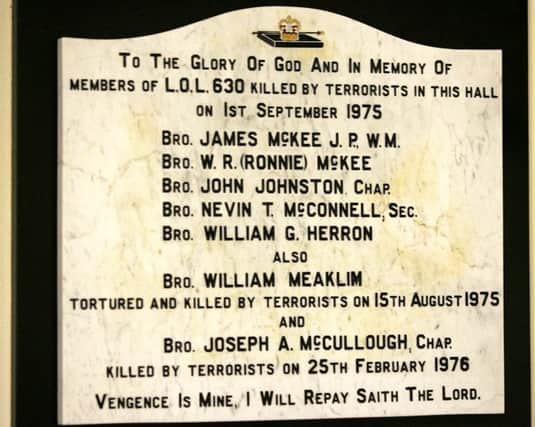Kingsmills suspect hair tested for inquest


The legacy inquest into the atrocity heard on Friday that fresh evidence has been found that could potentially be linked to one of the gunmen.
The information came to light during testimony of Dr Ruth Griffin, a retired senior forensic scientist who began her career in 1986 and assisted the Historical Enquiries Team (HET) examine the Kingsmills case.
Advertisement
Hide AdAdvertisement
Hide AdAlan Kane, QC for the families, revealed in court that hair was recovered from the scene of the Tullyvallen Orange Hall massacre which happened four months before the Kingsmills murders.
Mr Kane noted that the same suspects were involved in both attacks and, in the context of discussions on DNA evidence, asked Dr Griffin whether any effort has been made to link the hair to the suspects.
“Without seeing that file [Tullyvallen] I cannot say,” she replied. “There is nothing to suggest any work has been done.”
Mr Kane said to coroner Judge Brian Sherrard that the issue “may have to be followed up in case it may be of use”.
Advertisement
Hide AdAdvertisement
Hide AdMr Sherrard replied that there was “still some debate as to whether or not the hair still exists”.
However his counsel Sean Doran QC replied that the matter was raised by lawyers for the families in April and that two hairs relating to Tullyvallen had been recovered. The results of tests on them was now available for the coroner’s consideration, he said.
Mr Sherrard said he would take stock of the “investigative” matter next week.
The hairs cannot provide evidence on Kingsmills but could potentially provide a fresh link with the same gang for the Tullyvallen murders.
Advertisement
Hide AdAdvertisement
Hide AdA palm print from suspect S54 was taken from the Kingsmills getaway vehicle in 1976 and matched to him in May 2016. However a prosecution fell through in February as the vehicle could not be proven to have been at the crime scene.
Earlier in the hearing Mr Kane quizzed Dr Griffin about samples of soil, glass, metal and paint taken from the crime scene in 1976, with the intent of linking the vehicle to the massacre.
Some of the samples were destroyed in a lab fire eight months after the attack and the rest were destroyed in consultation with the RUC in 1982, which was normal if police considered there was little chance of a conviction, she said.
There was no record that any results from the tests were returned to the RUC in the eight months before the fire, she said. It would be normal for such tests to be given a low priority if it was considered there was little chance of conviction or if there were no suspects, she added.
Advertisement
Hide AdAdvertisement
Hide AdBut Mr Kane expressed concern that this could have given a blanket excuse not to do any forensic tests for south Armagh as attackers always fled across the border and out of reach of the RUC.
Ten Protestant workmen were travelling home from work in 1976 when their minbus was stopped near Kingsmills in south Armagh and they were gunned down. The PSNI holds the IRA responsible although it has never accepted responsibility.